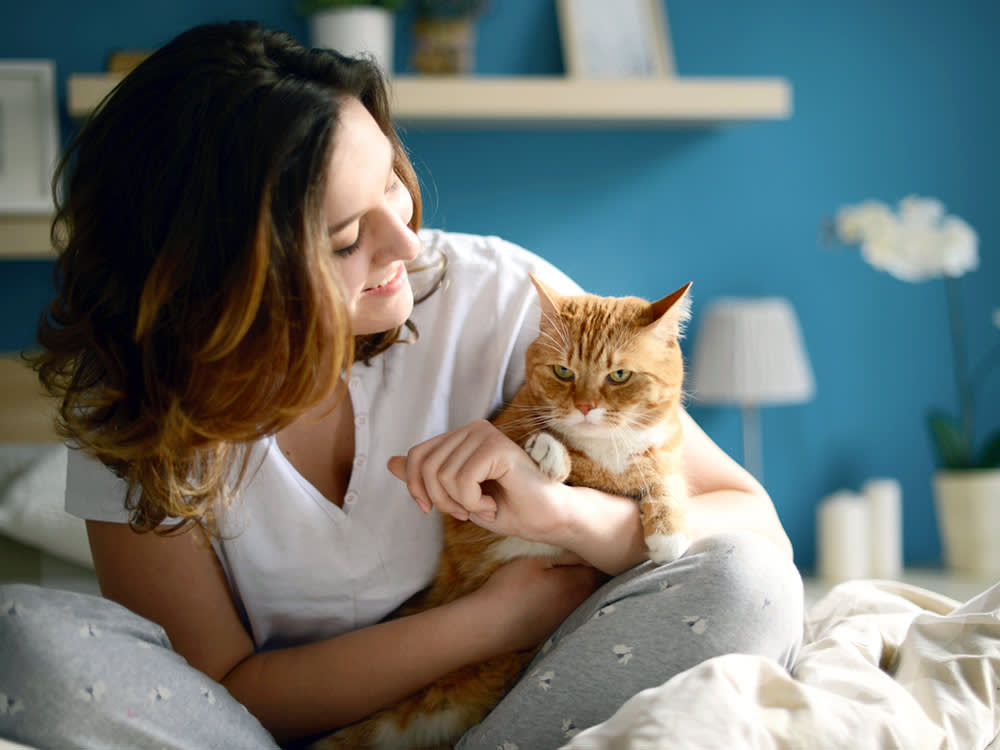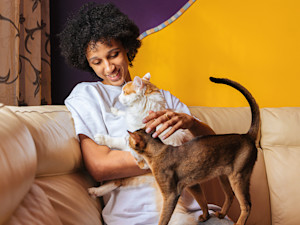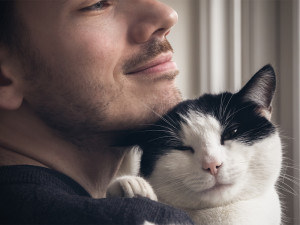People Are Bad at Knowing When Their Cats Are Annoyed, Study Says
We can tell when cats are happy, but we’re pretty bad at figuring out when they’re not

Share Article
Imagine you’re in couple’s therapy and beside you on the couch is your cat. Your therapist tells you both that listening with the intent to understand is important in every relationship. “But what about when your partner – um, cat – seems to lash out without warning?” you say. Your cat gives you a look. “Well, maybe you’re just not hearing the warning,” your therapist posits. OK... You look over at your cat. Their posture relaxes in a way that indicates they have won this particular argument and would like an apology.
A January study by French researchersopens in a new tab, published in the journal Applied Animal Behaviour, found that people were notably worse at understanding the signs that a cat was unhappy than they were at understanding the signs of cat contentment.

Get (totally free) deals for food, treats, accessories, tech and way more pet parenting must-haves.
opens in a new tabThe study also indicates that cat vocalisations are often misinterpreted and that pet parents should consider both physical and vocal cues when attempting to understand what their cat is feeling or attempting to communicate. But how do you better recognise your cat’s emotions, and why is it important that you do? Here’s what the study tells us.
What did the study find?
In the aforementioned study on human-cat communication, researchers asked 630 online participants (recruited through social media) to watch 24 video clips of cats experiencing different emotions and displaying different behaviours. The clips – which showed contentment, discontentment, solicitation (for either food or attention) and predatory behaviour – were presented as visual only, vocal only and then bimodal, meaning both visual and vocal.
The authors of the study noted that previous studies hadn’t examined humans’ ability to interpret cat communication from a bimodal perspective. And in fact, participants scored highest on the bimodal clips, with a 91.8 percent success rate. (With clips that only showed visual-only cues, participants scored 87.3 percent; vocal-only came in last with 72.2 percent.)
Contentment cues were the easiestopens in a new tab for people to recognise, with 90.1 percent getting it right, and discontentment was the hardest to identify, with only a 71.6 percent recognition score.
“I’m used to seeing negative states in cats,” says Charlotte de Mouzon, lead author of the study. “It’s something that really strikes me, when I see a cat showing negative signs. So I was surprised that this behaviour is understood less.”
Why are humans so bad at recognising discontentment?
Often, people just don’t know what to look out for when it comes to cat behaviour. “I think they’re untrained,” says de Mouzon. As a cat behaviourist, she sees it sometimes when helping people in their homes. “Most of the time, there are signs that they don’t know,” she adds.
For example, says de Mouzon, often people don’t realise that when a cat is licking their person’s hand, it can be a sign that they would like the person to stop petting them. Purring, too, can mean stress and anxietyopens in a new tab rather than contentment, depending on the context. “So, on the one hand, there is misknowledge,” says de Mouzon, offering that it’s also possible that because people love their cats, they just prefer to think of them as content.
Why is it important to understand what your cat is trying to communicate?
“Being misunderstood,” says de Mouzon, “is a matter of animal welfare.” For example, she says that if a cat doesn’t like to be stroked, and their human is in their personal space every day trying to pet them, “it’s actually a pressure that you put on them. If they’re trying to communicate that it’s uncomfortable for them, and if people don’t understand, then they will get stressed.”
This stress can affect a cat’s health and quality of life, and it can also result in negative outcomes for their human. “Some cats will express their stress by marking their environment more,” says de Mouzon. “And sometimes, they’ll express stress by biting the human, or hissing, or hiding from the human.”
Stress signals can be misinterpreted as simply ‘bad’ behaviour, leading to negative outcomes for the cat. “We had a client that was ready to rehome his cat,” Linda Hall, co-founder of the Cat Behavior Allianceopens in a new tab, says. “He went away for work; I think it was three days every month, and every time he came back, his cat had pooed on his pillow.”
He interpreted the action as the cat ‘punishing’ him for leaving, and was ready to get rid of the cat as a result. Hall explained (“I managed to say it nicely and politely,” she says) that his cat was not punishing him, but instead mixing his scent with his pet parent’s scent to comfort himself. “He’s pooing on your pillow because he loves you and misses you.”
Marking outside of the litter box, too, can mean a number of different things, depending on the other factors in play. In these situations, Rita Reimers, co-founder of the Cat Behavior Allianceopens in a new tab, who spoke to us alongside Hall, advises not to get angry, but to instead get curious. “You have to be a little analytical, instead of emotional,” she says. All behaviour is information.
Notice where is your cat peeing – is it, um, on you? Then they might be marking you as territory and expressing fear. If they’re doing it right outside of the litter box, it might be an issue with the litter box itselfopens in a new tab, or something medical (they might be connecting the litter box with the pain of urination), or maybe they’re intimidated by another cat in the home. If it’s on a perimeter wall, they might smell feral cats outside.
Basically, a single behaviour could mean many, many different things; it’s up to us to put the pieces together and figure out what our cat is trying to tell us. (Or work with a certified behaviourist, who can help us in our detective work.)
How can we get better at understanding our cats?
“Our study shows that it's important to look at your cats,” says de Mouzon. “Some people just don’t look at their cats. They hear the cat – they hear the meows, or the purrs – but they don’t look at the visual signs that the cat is trying to express. And communication is mostly about multimodal communication.”
It’s important to not only hear a purr or a meow, but notice what your cat’s body language is trying to tell you – is their body relaxed, open and loose? Are they blinking slowlyopens in a new tab? Then they’re likely content. That is not the case if their body is stiff and flattened, they’re blinking rapidly, their tail is swishing back and forth, or tucked, and their ears are plastered to their head.
“If your cat is purring and moving their tail at the same time, or they have their ears back – there are many visual signs of discomfort,” says de Mouzon. “But if you’re not looking at the cat, then you’re going to miss it.”
Pay attention, too, to changes in behaviour or vocalisationsopens in a new tab. “As they’re purring, listen,” says Hall. “Does it sound like it usually does when your is snuggled up on you, and cuddling you? Or is it louder, or a weird pitch?” It often comes down to really knowing your specific animal, and what normal behaviour and vocalisations look like for them.
She compares it to living with a human – there are some things that universally indicate something is physically wrong with people, like a high fever. But there are also some things that only indicate something is wrong to that specific person, like acting unusually cranky. “So it’s the same thing with cats,” she says. “Some cats are hiders, but if a cat that normally doesn’t hide is hiding, that could mean something.”
And if your cat is hissing, don’t be quick to anger. They’re not being mean; they’re expressing fear. “If a child came to me and said, ‘I’m scared,’” says Hall. “I wouldn’t say, ‘Knock it off’.” But she says if your cat is snarling, spitting or yelling, they’re still scared. “But they’re also worked up to the point that you should not try to touch them right now. Whatever mission you’re doing, you should abort.”
Of course, we aren’t born with the knowledge of how cats – and our cats in particular – communicate with humans. For this, pet parents will have to do some work. “Read, read, read,” says Reimers. “Look for reputable sources, because you could Google something on the internet and get 10 different answers.”
And of course, stay curious about your cat. For pet parents seeking to understand their cat’s communication, de Mouzon says “it’s about educating themselves, but it’s also about being attentive to their cats.”

Kelly Conaboy
Kelly Conaboy is a writer and author whose work has been featured in New York Magazine, The New York Times, and The Atlantic. Her first book, The Particulars of Peter, is about her very particular dog, Peter. (Peter works primarily as a poet.)
Related articles
![cat staring at person on table]() opens in a new tab
opens in a new tabWhy is My Cat Giving Me the Evil Eye?
...Is it something I said?
![A cat headbutting a woman on her laptop.]() opens in a new tab
opens in a new tabWhy Does Your Cat Headbutt You? Curious Cat Behaviour Explained
Apparently, you should take it as a compliment
![cat snuggling man]() opens in a new tab
opens in a new tabWhat’s Your Cat’s Love Language?
Five surprising ways cats show affection (and how you can show it back), according to a cat behaviourist
![dark-haired woman hugging cat that has imprinted on her]() opens in a new tab
opens in a new tab10 Signs Your Cat Has Imprinted On You
Feeling like you have a little shadow these days? A cat behaviourist explains why that’s happening
![A cute cat laying on the ground with wide eyes]() opens in a new tab
opens in a new tabWhat Your Cat’s Sexy ‘Slow Blink’ Actually Means
Cat behaviourist Cristin Tamburo on how to read cat eyes






